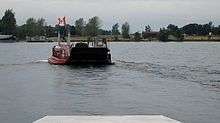Simcoe Island
| Geography | |
|---|---|
| Location | Lake Ontario |
| Coordinates | 44°10′05″N 76°31′27″W / 44.16806°N 76.52417°W[1]Coordinates: 44°10′05″N 76°31′27″W / 44.16806°N 76.52417°W[1] |
| Archipelago | Thousand Islands |
| Administration | |
|
Canada | |
| Province | Ontario |
| County | Frontenac County |
| Township | Frontenac Islands |
| Population | (2001) |

Simcoe Island is a small island approx. 3½ km long, and one km across at its' widest point, in Lake Ontario, just off Wolfe Island, close to Kingston, Ontario, and Amherst Island.
The island is almost completely farmland and can be reached by ferry from Wolfe Island. Part of Frontenac County, it forms the township of Frontenac Islands, Ontario with Wolfe Island and Howe Island, together with smaller, privately owned islands, Garden Island and Horseshoe Island.
In 1792, scant months after the partition of Quebec into the provinces of Upper Canada and Lower Canada, Lieutenant-Governor John Graves Simcoe named the archipelago at the head of the St. Lawrence river for the victorious Generals at the Battle of the Plains of Abraham: James Wolfe, Jefferey Amherst, William Howe, Guy Carleton and Thomas Gage. The last is now known as Simcoe Island.
Although the island was originally named Isle de Foret ("Forest Island") by early French settlers, most of the trees on the island have been removed for farming, with the exception of small isolated forests and trees. The name Gage Island was also used for a period of time. The name Simcoe was given to the island in honour of John Graves Simcoe.
The two main points of interest on the island are the cable ferry, one of the smallest in Ontario (holding a maximum of three cars), and the Nine Mile Point Lighthouse, accessible by the island's only main dirt road, Nine Mile Point Road. The lighthouse was built in 1833 and is an "Imperial" style light 40 feet high. Originally, this light was manually operated, but it is now fully automated. It is now a federal heritage building, and the graveyard of many ships sunk off the point, including the Comet, a paddle steamer from the United States, the Aloha, a 171-foot-long vessel, and the Effie Mae, which collided with the Aloha.
References
- 1 2 "Simcoe Island". Geographical Names Data Base. Natural Resources Canada. Retrieved November 24, 2010.